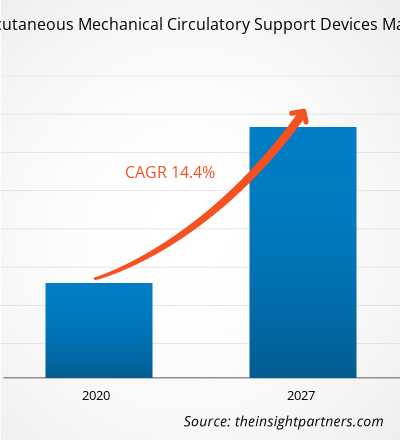The Asia Pacific percutaneous mechanical circulatory support devices market is expected to reach US$ 689.47 million by 2027 from US$ 240.88 million in 2019; it is estimated to grow at a CAGR of 14.4% from 2020 to 2027.
The rising geriatric population, increasing prevalence of cardiovascular diseases and shortage of heart donors are the key factors driving the growth of percutaneous mechanical circulatory support devices. However, high costs of these devices and procedures associated with them, and impact of COVID-19 pandemic on medical device industry is the major factor hindering the market growth in Asia Pacific.Percutaneous mechanical circulatory support devices offers an effective and rapid approach to slow the downward spiral of hemodynamic instability among patients suffering with decompensated heart failures and cardiogenic shocks till a more definitive strategy is perceived among patients to recover from these cardiac ailments. The major roles of the percutaneous mechanical circulatory support devices include improving the native cardiac output, reducing ventricular volume and filling pressures, augmenting coronary perfusion, and maintaining vital organ perfusion.
The percutaneous mechanical circulatory support devices are majorly used as a bridge to help patients suffering from cardiogenic shocks and heart failures. These disease conditions usually fall under the most commonly encountered cardiovascular diseases, which have a high burden and prevalence. In spite of the increase in the attribute of metabolic disorders to the incidence of cardiovascular disease (CVD), hypertension remains the most important risk factor in Japanese people. According to the Public Health Center-based prospective (JPHC) Study conducted in March 2017, cardiovascular disease is an established risk factor of stroke and heart failure in many older individuals too.
Heart disease is the leading cause of death for people in Asia Pacific. according to the American Health Association Journal, in 2016, the estimated prevalence of CVDs in India was estimated to be 54.5 million. 1 in 4 deaths in India are because of CVDs with ischemic heart disease and stroke responsible for >80% of this burden. For instance, the Global Burden of Disease (GBD) study estimate of age-standardized CVD death rate of 272 per 100 000 population in India is higher than the global average of 235 per 100 000 population.
Various research studies show that improvements and experience with percutaneous mechanical circulatory support may offer the prospect of better outcomes. Thus, the high prevalence of cardiovascular diseases that majorly includes heart failure conditions rising across Asia Pacific region to which mechanical circulatory devices have emerged as potential solutions for patients’ treatment is likely to boost the growth of the percutaneous mechanical circulatory support devices market
Covid-19 pandemic is making its way to all Asia Pacific countries. Due to growing COVID-19, these countries are expecting to witness a huge challenge and are expected to affect largely to healthcare industries in the current situation. Due to growing COVID-19, healthcare professionals are taking precautions ensure that appropriate work practices are followed to prevent direct contact with infectious material, percutaneous injury and hazards related to moving heavy remains. In India, it has been reported the total number of confirmed cases has been increased to 33,000 with 1000 death. Similarly, in China, 84,400 confirmed cases and 4,600 deaths are reported. These numbers are changing owing to various factors such as the prevalence of chronic disease patients, surgeries, population density in regions, and other factors. Restrictive measures have been taken to control the spread of this pandemic. Moreover, due to surgeries, the number of COVID-19 numbers is also growing. This pandemic is affecting the business operation of the various key players operating in this region.
Rest of Asia Pacific Percutaneous Mechanical Circulatory Support Devices Market, Revenue and Forecast to 2027 (US$ Mn)

- This FREE sample will include data analysis, ranging from market trends to estimates and forecasts.
ASIA PACIFIC PERCUTANEOUS MECHANICAL CIRCULATORY SUPPORT DEVICES MARKET SEGMENTATION
By Product
- Intra-Aortic Balloon Pumps
- VA-Extracorporeal Membrane Oxygenation (ECMO)
- Short-Term Ventricular Assist Devices (VADs)
- Impella
- Tandem Heart
By End User
- Hospitals
- Ambulatory Surgical Centers
- Others
By Country
- China
- Japan
- India
- Australia
- South Korea
Company Profiles
- Abbott
- Livanova Plc (Cardiacassist, Inc)
- Eurosets
- Berlin Heart
- Medtronic
Asia Pacific Percutaneous Mechanical Circulatory Support Devices Report Scope
| Report Attribute | Details |
|---|---|
| Market size in 2019 | US$ 240.88 Million |
| Market Size by 2027 | US$ 689.47 Million |
| Global CAGR (2020 - 2027) | 14.4% |
| Historical Data | 2017-2018 |
| Forecast period | 2020-2027 |
| Segments Covered |
By Product
|
| Regions and Countries Covered | Asia-Pacific
|
| Market leaders and key company profiles |
- Historical Analysis (2 Years), Base Year, Forecast (7 Years) with CAGR
- PEST and SWOT Analysis
- Market Size Value / Volume - Global, Regional, Country
- Industry and Competitive Landscape
- Excel Dataset



Report Coverage
Revenue forecast, Company Analysis, Industry landscape, Growth factors, and Trends

Segment Covered
Product, End User, and Country

Regional Scope
North America, Europe, Asia Pacific, Middle East & Africa, South & Central America

Country Scope
Australia, China, Japan, South Korea

 Get Free Sample For
Get Free Sample For